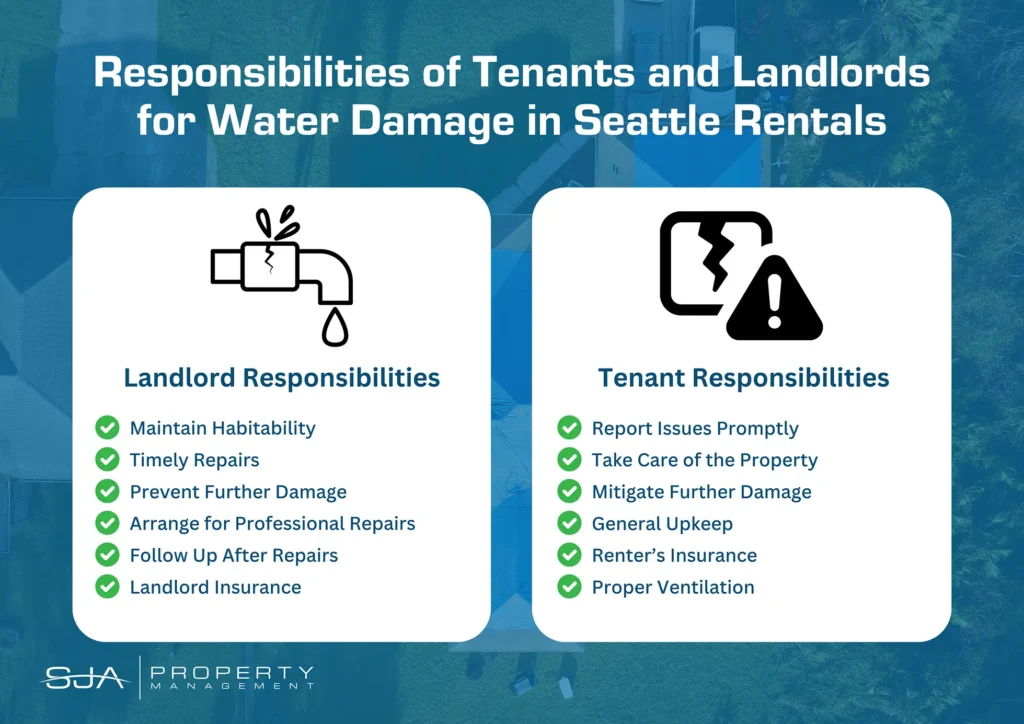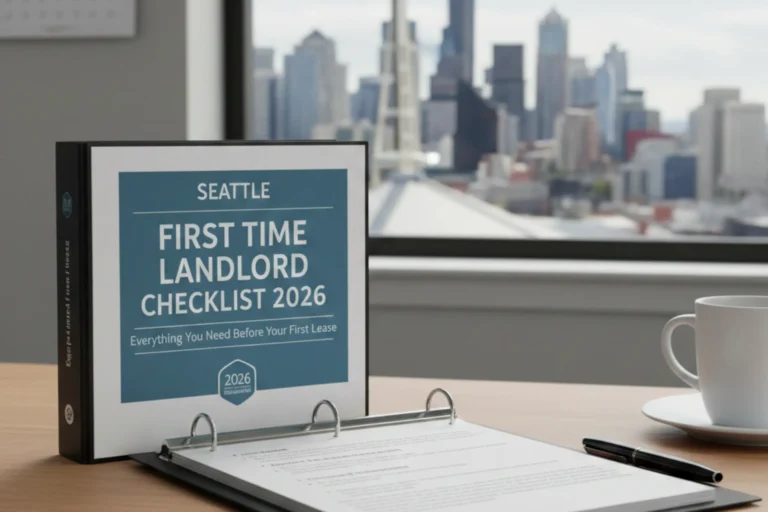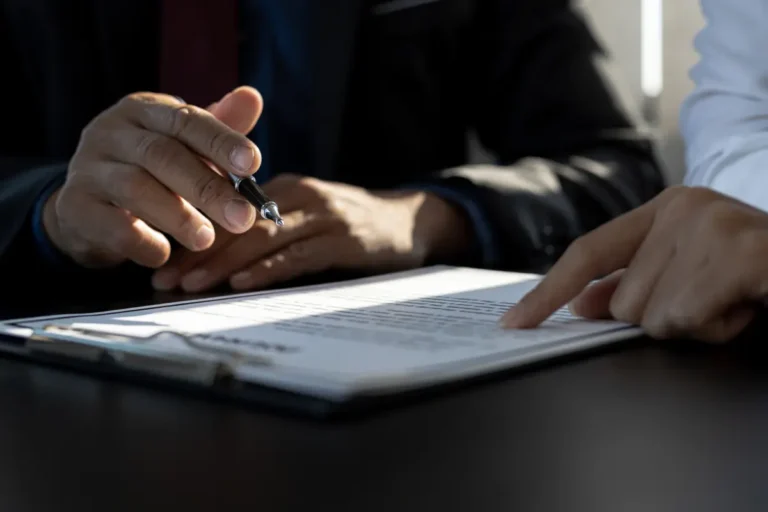Water damage is, sadly, a common occurrence in rental properties. But who is responsible for water damage—the tenant or the landlord? Understanding the general responsibilities of both landlords and tenants is crucial for addressing water damage and other maintenance issues in Seattle rental properties.
In this article, we’re sharing our expertise on the subject so you know who is responsible for what if your rental property is ever affected by water damage.
Key Takeaways
- Landlords are responsible for maintaining the property, including fixing leaks, plumbing issues, and addressing water damage promptly to ensure habitability.
- Tenants must report water damage immediately, take steps to mitigate further damage, and avoid causing damage through negligence.
- Both landlords and tenants should maintain open communication and cooperate in resolving water damage issues to prevent disputes.
- Landlord insurance typically covers water damage repairs, but tenants should have renter’s insurance for protection of personal belongings.

Landlord Responsibility for Water Damage
When it comes to water damage, maintenance, and repairs, a lot of the responsibility falls to the landlord.
Habitability and Maintenance
Landlords are required to maintain their rental properties in a condition that is safe, livable, and compliant with health and safety codes. This includes making necessary repairs to prevent or address water damage, such as fixing leaks, maintaining plumbing systems, and ensuring the structure of the property (e.g., roof, walls) is intact. The landlord must maintain these aspects of the property and ensure they meet the standards set by your city and the state of Washington.
Timely Repairs
Once the landlord is notified of a water leak or damage, they are generally required to make repairs within a reasonable time. For significant issues, such as flooding or plumbing problems that affect the habitability of the unit, landlords must act quickly—usually within 24 to 48 hours. If a landlord fails to address water damage promptly, they could be in violation of Washington state’s habitability laws.
Preventing Further Damage
If water damage is a result of the landlord’s failure to maintain the property, because of an unresolved plumbing issue for example, they are responsible for preventing further damage. AS the landlord, you must also address mold or mildew growth caused by prolonged water exposure, as this can directly impact tenant health and safety.
Tenant Responsibility for Water Damage
While a lot falls into the lap of the landlord, there are key responsibilities that are expected of tenants in Seattle rental properties.
Reporting Issues Promptly
Tenants have a responsibility to report any water damage or issues to the landlord as soon as possible. Whether it’s leaking pipes, broken appliances, or moisture in strange places, tenants must report these issues as quickly as possible—prompt notification allows the landlord to address the issue before it worsens. Under Washington state law, failure to report damage in a timely manner could lead to tenants being held partially responsible for any further damage.
Taking Care of the Property
When a tenant signs a lease, they are expected to take care of the property and do everything they can to avoid damage. So, tenants shouldn’t flush foreign objects down the toilet, wash oversized comforters in their washing machine, or use other appliances or fixtures in a way that could lead to water damage. If the damage is found to have been caused by tenant negligence the tenants may be held financially responsible for the damage and be required to pay for the repairs.
Mitigating Damage to the Property
If water damage is found on the property, tenants must take reasonable steps to prevent the damage from getting worse. Depending on the situation, this could mean shutting off the water, using towels or buckets to contain the leak, moving furniture to a dry area, and/or cleaning up any standing water. Being able to take quick action to mitigate damage can prevent further destruction and keep the costs for repairs down.
General Upkeep
Tenants are typically responsible for minor maintenance tasks that can help avoid damage, like regularly cleaning drains or replacing water filters in appliances. If damage is caused by a tenant’s failure to properly maintain the property, they may be held liable for repair costs.
The Shared Responsibility Between Landlord and Tenant
In our experience in the industry, the best landlord/tenant relationships understand the shared responsibility of communicating clearly and cooperating. It’s a give-and-take relationship where both parties have to communicate effectively and cooperate when it comes to fixing issues on the property. While the landlord is responsible for major repairs and ensuring the property is habitable, tenants must take reasonable steps to keep the property in good condition and report problems as soon as they arise. Open communication between both parties can help ensure that water damage and other maintenance concerns are handled efficiently and appropriately.
By clearly understanding these roles and responsibilities, both landlords and tenants can work together to maintain a safe and comfortable living environment, avoid disputes, and address any water damage or other issues as soon as they arise.
What Should You Do When Water Damage Happens?
We’ve seen how expensive and time-consuming water damage can be in a rental unit. Quick action can ensure that it doesn’t become a bigger problem, protecting your interests as the landlord and those of your tenants. Whether the damage is caused by a burst pipe, a leaking roof, or an appliance malfunction, tenants and landlords must work together to resolve the situation efficiently.
Step 1: Tenant Must Notify Landlord
As soon as the tenant notices water damage, the first step is to notify the landlord. Tenants should provide detailed information about the issue, such as the location of the damage, the cause, and the severity of the situation.
Tenants should take clear photographs or videos of the water damage as soon as possible. Documenting the extent of the damage can help both the tenant and landlord with insurance claims or legal disputes down the line.
Step 2: Landlord to Advise Tenants
After your tenants have informed you of the problem, ensure that they’ve taken all necessary steps to prevent any further damage. These steps include:
- Turning off the water supply to the affected area.
- Moving furniture or personal belongings away from the affected area.
- Using towels, buckets, or mops to soak up standing water.
Tenants shouldn’t attempt to make repairs themselves, these reasonable steps can help minimize further damage.
Step 3: Assess the Situation and Respond Promptly
Now it’s time for you to assess the situation as soon as possible. If the water damage is severe, you must address the issue immediately and hire professionals to make repairs as soon as possible. You want to stop further water intrusion and begin repairs before the situation worsens, to protect your property and lessen the impact on your tenants as much as possible.
Step 4: Arrange for Necessary Repairs
Whether you need to hire a plumber to fix a leaking pipe, a roofer to patch a leaking roof, or a contractor to address structural damage, it’s the landlord’s responsibility to arrange for professional repairs. In cases of significant damage, the landlord may need to address mold remediation and other long-term repairs. The landlord should communicate timelines to the tenant, providing updates on when repairs will be completed and how long any disruption might last.
Step 5: Follow Up on Repairs and Restoration
After repairs are completed, you should follow up to ensure the property is restored to a habitable condition. This includes checking for any residual damage, ensuring that all plumbing, heating, and electrical systems are functioning properly, and addressing any lingering issues such as mold or mildew caused by water exposure. Check in with your tenants once repairs are complete to make sure everything is in working order.
Does Landlord Insurance Cover Water Damage?
In most cases, landlord insurance will cover the cost of repairs for water damage caused by factors like plumbing failures or roof leaks. However, tenants should not expect the landlord’s insurance to cover their personal property or belongings. It is important for tenants to understand that they may need renter’s insurance to protect their possessions.
Tenants should check their renter’s insurance policy to see if it covers water damage to their personal property. If the damage to the tenant’s belongings is significant, renter’s insurance can help cover the cost of repairs or replacement. Tenants should document and file claims with their insurance company as soon as possible.
Managing Your Property Doesn’t Have to be Difficult
If you’re looking for a way to provide your tenants with a stellar experience but want to take a step back from the management, SJA Property Management is the solution you’re looking for. We provide our clients with the highest level of professional property management services in the Seattle area.
Water Damage to Rental Property FAQs
How long does a landlord have to fix water damage in Washington?
In Washington state, landlords must fix water damage within a reasonable time, usually 24-48 hours for emergencies and up to 30 days for less urgent issues. If not repaired, tenants may have the right to withhold rent, make repairs, or terminate the lease.
Who pays when there is a water leak?
In Seattle, the landlord is typically responsible for repairing water leaks unless the damage is caused by the tenant’s actions. Tenants must promptly notify the landlord, so repairs can be made in a timely manner.
What repairs are landlords responsible for in Washington state?
In Seattle, landlords are responsible for repairs that ensure the rental property is safe and habitable, including fixing issues with plumbing, electrical systems, heating, and structural damage. Tenants are responsible for repairs caused by their own negligence or misuse, such as fixing broken appliances they damaged or paying for damage from leaving a leak unchecked.
What makes an apartment uninhabitable in Washington state?
An apartment is considered uninhabitable in Washington State if it has serious issues like lack of water, heat, or electricity, significant mold, or dangerous structural damage.






